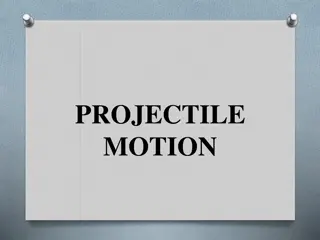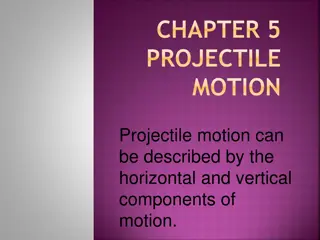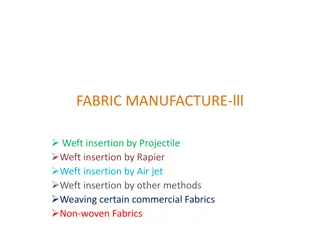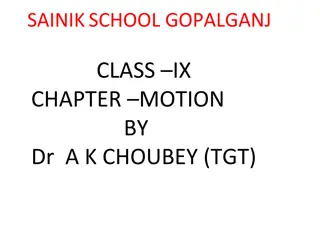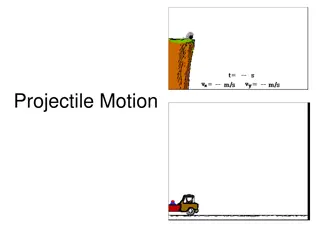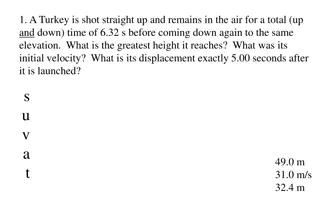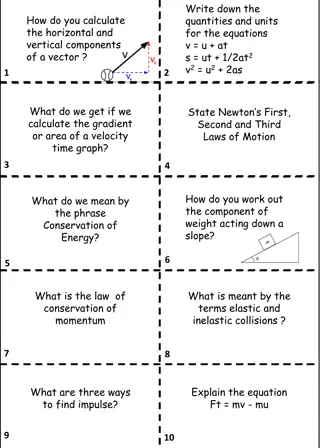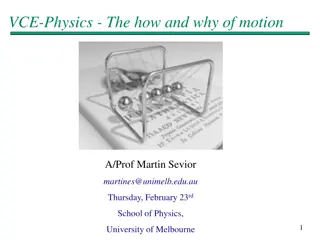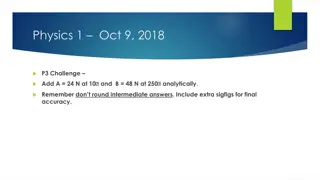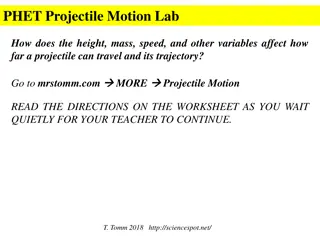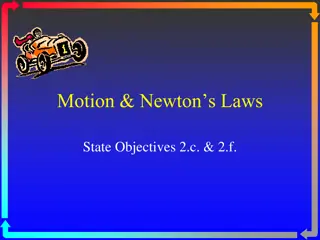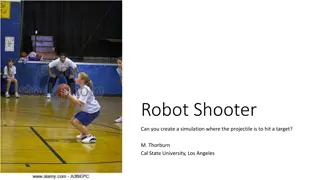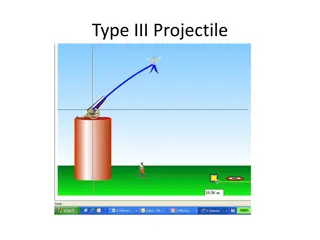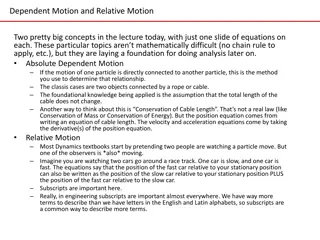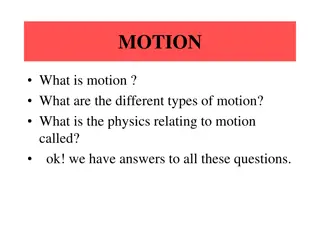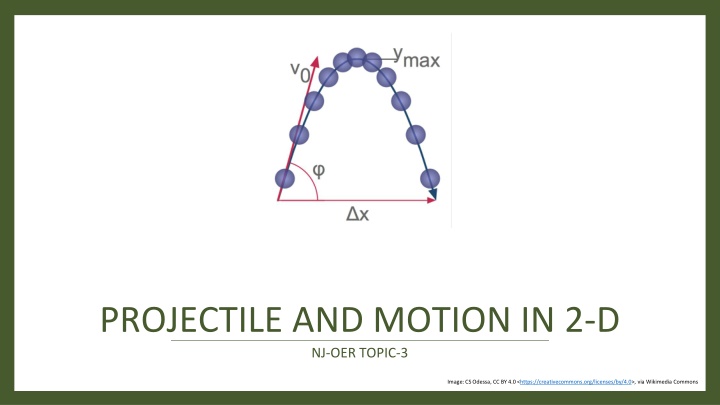
Projectile Motion in Two Dimensions
Explore the principles of projectile and motion in 2-D, focusing on the independence of horizontal and vertical components, vector addition, and solving 2-D motion problems. Learn about range, maximum height, velocity, trajectory of a projectile, and more through graphical and analytical methods.
Download Presentation

Please find below an Image/Link to download the presentation.
The content on the website is provided AS IS for your information and personal use only. It may not be sold, licensed, or shared on other websites without obtaining consent from the author. If you encounter any issues during the download, it is possible that the publisher has removed the file from their server.
You are allowed to download the files provided on this website for personal or commercial use, subject to the condition that they are used lawfully. All files are the property of their respective owners.
The content on the website is provided AS IS for your information and personal use only. It may not be sold, licensed, or shared on other websites without obtaining consent from the author.
E N D
Presentation Transcript
PROJECTILE AND MOTION IN 2-D NJ-OER TOPIC-3 Image: CS Odessa, CC BY 4.0 <https://creativecommons.org/licenses/by/4.0>, via Wikimedia Commons
Original Publication Year 2022 General Physics I by Moe Tabanli is licensed under aCreative Commons Attribution-NonCommercial-ShareAlike 4.0 International License, except where otherwise noted. To learn more about the Open Textbook Collaborative, visit https://middlesexcc.libguides.com/OTCProject Under this license, any user of this textbook or the textbook contents herein must provide proper attribution as follows: If you redistribute this textbook in a digital or print format (including but not limited to PDF and HTML), then you must retain this attribution statement on your licensing page. If you redistribute part of this textbook, then you must include citation information including the link to the original document and original license on your licensing page. If you use this textbook as a bibliographic reference, please include the link to this work https://opennj.net//physics- tabanli in your citation. For questions regarding this licensing, please contact library@middlesexcc.edu Funding Statement This material was funded by the Fund for the Improvement of Postsecondary Education (FIPSE) of the U.S. Department of Education for the Open Textbooks Pilot grant awarded to Middlesex College (Edison, NJ) for the Open Textbook Collaborative. Open Textbook Collaborative The Open Textbook Collaborative. (OTC) project is a statewide project managed by Middlesex College along with assistance from Brookdale Community College, Ocean County College , Passaic County Community College, and Rowan University . The project engages a consortium of New Jersey community colleges and Rowan University to develop open educational resources (OER) in career and technical education STEM courses. The coursesalign tocareer pathways in New Jersey s growth industries including health services, technology, energy, and global manufacturing and supply chain management as identified by the New Jersey Council of Community Colleges.
Observe that motion in vertical direction on Earth Understand the independence of horizontal and vertical components in two-dimensional motion Understand the rules of vector addition and subtraction Apply graphical and analytical methods of vector addition Understand different vector representations and their relationship such as magnitude/angle; component form, graphical representation, vector representation Identify, explain and determine range, maximum height, time for fall, velocity and trajectory of a projectile. Apply the principle of independence of motion to solve general 2-D motion problems. Apply principles of vector addition to determine relative velocity and explain the significance of the observer. Learning Outcomes
x = displacement in x y = displacement in y vo= initial velocity vox = initial velocity in x voy = initial velocity in y vfx =final velocity in x vfy = final velocity in x t = time or duration g= gravitational acceleration ax = acceleration in x ay = acceleration in y VAB=Velocity of object A with respect to observer B = angle measured from the +x-axis Concepts
Position, displacement, distance are in meters m Velocity and speed are in meters per second m/s Acceleration is in meters per second square m/s2 Angle in degrees or radian Units
x = vox t + ax t2 vfx=vox + ax t vfx2- vox2= 2ax xa vox = vo cos( ) voy = vo sin( ) ax = a cos( ) ay = a sin( ) v2= vx2+ vy2 a2= ax2+ ay2 tan = vy/ vx y= voyt + ayt2 vfy= voy+ ay t vfy2- voy2= 2ay y Free fall or projectile vfx=vox ax=0 ay=-g g= 9.8 m/s2 Formulas Relative velocity Vab = Vao + Vob
KEY STRATEGIES Draw the motion diagram, identify given quantities and the unknown For 2-D problems use trigonometry to identify components Substitute the known quantities and solve for the unknown using algebra Maximum height happens at the time when vfy=0. Set vfy to zero, solve for t Time for the fall is calculated using y=0 or (yf-yi)=-(initial height) Range is calculated in the x-axis at the time when y=0 Impact speed can be calculated using the timeless equation of kinematics Released means vo=0
MODEL PROBLEM Q) An object is projected upward from the ground with 15.0 m/s speed. A) When will it reach the maximum height B) What is the maximum height C) If the object continues its motion after reaching the y-max, what is the impact velocity and what is the time for fall.
ACTIVITY PROJECTILE Q) An object is projected upward from the ground with 15.0 m/s speed. A) When will it reach the maximum height? B) What is the maximum height? This problem can be simulated using an online activity. Run the app, obtain the results from the app and compare it with your calculations. Open Phet Projectile simulation https://phet.colorado.edu/en/simulations/projectile-motion Choose intro or lab. Set the initial height to zero and initial speed to 15m/s. Hit the red button and launch the projectile Using the probe on the top right, next to the initial values, measure the maximum height and the time for the projectile to reach the maximum height. Compare it with your calculations Simulation by PhET Interactive Simulations, University of Colorado Boulder, licensed under CC-BY-4.0 (https://phet.colorado.edu).
ACTIVITY PROJECTILE Q) An object is projected upward with 10.0 m/s speed from 5 meters height. A) When will it reach the maximum height? B) What is the maximum height? C) Find the impact velocity using timeless equation of kinematics. Using Vfy equation find the total time for fall. D) Obtain the height at t=0.2s by substituting t=0.2 in y equation Run the app, obtain the results from the app and compare it with your calculations. IMPORTANT NOTES: Kinematics equation gives Y. You need to add the initial height in order to find ymax For the impact velocity, Vfy is always negative Simulation by PhET Interactive Simulations, University of Colorado Boulder, licensed under CC-BY-4.0 (https://phet.colorado.edu).
ACTIVITY DOWNWARD PROJECTILE Q) An object is projected DOWNWARD with 10.0 m/s speed (viy=-10m/s) from 5 meters height. A) What is the maximum height? C) Find the impact velocity using timeless equation of kinematics. Using Vfy equation find the total time for fall. D) Obtain the height at t=0.2s by substituting t=0.2 in y equation Run the app, obtain the results from the app and compare it with your calculations. IMPORTANT NOTES: For downward projectile, ymax is the original height For all the downward projectile viy is negative. Slider tool gives the speed which is the magnitude. Simulation by PhET Interactive Simulations, University of Colorado Boulder, licensed under CC-BY-4.0 (https://phet.colorado.edu).
ACTIVITY Using the given initial values run the simulation. Obtain the results using the probe. Using equation of kinematics calculate the values and compare Yi(m) Viy(m/s) Ymax(m) Time for Ymax (s) Time for fall (s) Ymax (calculated) Time for ymax (calculated) Time for fall calculated(s) 5 9 6 -8 0 10 11 0 11 2 11 -2
REVERSE PROBLEMS, FINAL IS GIVEN INITIAL IS ASKED Q) An object is projected upward from a tower. It reaches ymax=20 meters at t=2.0 seconds. A) What was the initial velocity viy? B) What was the initial height. C) If it continues the motion, what would be the impact velocity, and time for fall Do the same problem model using different given numbers 1) ymax = 20m t=1.5s Find Viy and the height 2) ymax = 10m t=2.5s Find Viy and the height (this is a projectile from a water well 3) ymax=? t=3 seconds h=12 meters find viy and ymax
VECTOR REPRESENTATIONS 2-D Motion Graphical Magnitude/Angle Components 3 units at 45 degrees Vx=3 cos45=2.1 units Vy=3 sin45 =2.1 units Vector Representation V=2.1 i + 2.1 j QUADRANTS AND DIRECTIONS First quadrant both components +, second quadrant x component - third quadrant both components -, fourth quadrant y component -
MODEL PROBLEMS vx =v cos( ) vy=v sin( ) v=|v|=sqrt(vx2+ vy2) Pythagorean Theorem tan =vy/vx ?=tan-1(vy/vx) or ?=tan-1(vy/vx)+ based on quadrant v= vx i + vy j angle measured with respect to x-axis angle measured with respect to x-axis 1) x-component of velocity is vx=3m/s and y component is vy=4m/s. Write the velocity as vector representation, in magnitude/angle form, and show it graphically v= 3 i + 4 j V has a magnitude of 5m/s making 53degrees with the x-axis v 2) An object has an acceleration of 4.0 m/s^2 making 45 degrees with the x-axis. Find ax,ay. Show the vector ax =a cos( ) ay=a sin( ) ax=2.3m/s^2 ay=-2.3 m/s^2 a
ACTIVITY VECTORS One representation of an acceleration vector a is given. Find the other representations. Choose a suitable scale for the graphical interpretation. For the last problem there are Magnitude Angle Form two solutions. Component Form Vector Form Graphical Magnitude Angle ax ay ax i + ay j Choose a scale. Show the arrow in the correct direction 15 53.1 -5 -5 Two units to the West 12i + 5j 5 3
ACTIVITY VECTORS Open https://phet.colorado.edu/en/simulations/vector-addition Choose explore 2-D. Drag the vector "a" to the cartesian coordinates. Explore the sign for the vector components in various quadrants by rotating or resizing the vector.
ACTIVITY VECTORS USING PHET Go to https://phet.colorado.edu/en/simulations/vector-addition and choose explore 2-D Drag the vector "a" and verify your answers Come up with your own problems and explore Magnitude Angle Form Component Form Vector Form Graphical Magnitude Angle ax ay ax i + ay j Choose a scale Show the arrow 15 53.1 -5 -5 12i + 5j 5 3
2-D PROJECTILE Horizontal x-axis Vertical y-axis y =voy t - g t2 vfy=voy -gt vfy2- voy2= -2g?y x =vox t vfx=vox Three Cases A) Horizontal projectile from a height, Voy=0 B) Diagonal projectile from the ground, y=0 at impact C) Diagonal projectile from a height, general case
Model Problem Horizontal Projectile Q) A piece of rock projected horizontally from a cliff. It stays in the air for 6.0 seconds before hitting the ground and travels a range of 288 meters measured from the bottom of the cliff. Neglect the friction. What was the height it was projected from? What was its initial velocity? What is y-component of the final velocity at the impact. Find the impact speed.
Model Problem Diagonal Projectile Q) A golf ball is hit from the ground with an angle of 30 degrees with the x-axis. Golf ball has an initial speed of 10.0 m/s. What are the x and y components of initial velocity How long will it stay in the air? What is the range? What is the impact speed?
ACTIVITY 2-D HORIZONTAL PROJECTILE Open https://phet.colorado.edu/en/simulations/projectile-motion Drag the cannon up to the initial height Rotate the cannon to zero degrees, adjust the speed Q1) An object is projected horizontally from 5 meters height with 6m/s speed Calculate its location in x and y after 0.2 seconds Using the height, calculate time for fall Using the time and the initial speed calculate its range Verify your values using the simulation Repeat the activity for various heights and speed. Simulation by PhET Interactive Simulations, University of Colorado Boulder, licensed under CC-BY-4.0 (https://phet.colorado.edu).
ACTIVITY 2-D DIAGONAL PROJECTILE Open https://phet.colorado.edu/en/simulations/projectile-motion Drag the cannon up to the initial height Rotate the cannon to zero degrees, adjust the speed Q1) An object is projected with 60 degrees angle diagonally from the ground. Initial speed is 6m/s When will it reach the maximum height (Vfy=0) What is the maximum height Find the time for fall and the range Verify your values using the simulation Repeat the activity for various height, speed and angle. Simulation by PhET Interactive Simulations, University of Colorado Boulder, licensed under CC-BY-4.0 (https://phet.colorado.edu).
General 2-D Motion For motion on the surface of the Earth, we can take North as +y axis and East as +x axis. We treat the motion as if it is two separate motion x = vox t + ax t2vfx=vox + ax t vox = vo cos( ) ax = a cos( ) y = voy t + ay t2vfy=voy + ay t voy = vo sin( ) ay = a sin( ) Q)A car is initially moving 37 degrees North of East with 20 m/s. It accelerates suddenly towards South with a=4m/s^2. Find ax.ay,vox and voy. Find the displacement in x,y and the final velocity components vfx and vfy in two seconds.
Classwork-Complete the Table x = vox t + ax t2vfx=vox + ax t vox = vo cos( ) ax = a cos( ) y = voy t + ay t2vfy=voy + ay t voy = vo sin( ) ay = a sin( ) Vo a t(s) deltaX deltaY Vfx Vfy Vox=4m/s Voy=3m/s ax=2m/s^2 ay=- 1m/s^2 3 Speed 5m/s angle=30 a= 4 m/s^2 West 4 6 m/s North 2 m/s^2 East s ax=2m/s^2 ay=- 1m/s^2 6 15 m/s 12 m/s Vox= 20m/s Voy=15m/s 8 120 meters 140meters Come up with your own questions. Make sure they are consistent and sufficient to solve
RELATIVE VELOCITY USING VECTOR ADDITION A B A+B = (Ax+Bx) i + (Ay + By) j = = Ax i + Bx i + Ay j By j A B A+B=15 i + 10j = 3 i 4 j = 12 i + 14j
RELATIVE VELOCITY USING VECTOR ADDITION Vab = Velocity of object a with respect to the observer at b Vbc = Velocity of b with respect to the observer c Vac = Velocity of object a with respect to the observer c Vab = -Vba For some problems we need to use the formulas above to match index Vbc = -Vcb Vac = -Vca EQUATION: Vab + Vbc = Vac REPEATED INDEX MUST BE ADJACENT
MODEL PROBLEM 1) Alex is swimming North with 2m/s speed with respect to Big Sur River. The river is flowing with 3 m/s speed East with respect to Cathy who is observing Alex from the bank. What is the velocity of Alex with respect to Cathy. Vab=Velocity of Alex with respect to Big Sur River. Vbc= Velocity of Big Sur River with respect to Cathy. Vac=Velocity of Alex with respect to Cathy. Vab = 2i + 0j Vbc= 0i + 3j Vac = 2i + 3j
Classwork 1) Vto = 4 i 5j 2) Velocity of an airplane with respect to the tower is 400mph 45o Northeast. Velocity of the wind with respect to tower is 30 mph East. What is the velocity of the airplane with respect to the wind. 3) Vcb = 4j Vca=3 i 3j Find Vab 4) A swimmer wants to swim towards North with 2 m/s speed with respect to an observer on the bridge. River runs with 4 m/s towards west with respect to the bridge. What should be velocity of the swimmer with respect to the river 5) Vab= 3i Vac=5i +6j Find Vbc and Vcb Vqt = 3i+6 j Vqo=?
REFERENCES Slide 1: CS Odessa, CC BY 4.0 <https://creativecommons.org/licenses/by/4.0>, via Wikimedia Commons Slide 8-9-10-16-21-22 Screenshot from PhET Interactive Simulations University of Colorado Boulder Simulation by PhET Interactive Simulations, University of Colorado Boulder, licensed under CC-BY-4.0 (https://phet.colorado.edu).

